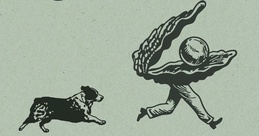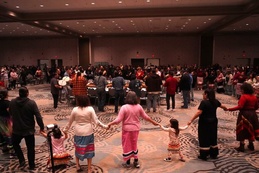A sled dog summer
July 18, 2007
A four-dog morning is part of Mike King’s daily routine.The owner of four Siberian Huskies, a matched set with glorious strawberry blonde fur (technically known as light red,) most mornings find King exercising and training his dogs as they pull him around Traverse City on a light cart. During winter months, King rides a traditional sled over the snow.
Each day, whether lounging outside Oryana Food Coop in the shade while their owner has a cup of coffee, running gleefully along the TART Trail or plunging into the bay, Timber, Danni Girl, Ginger and Tess relish their workout.
Tongues lolling and eyes bright, they are always ready for action at their master’s command. Instant conversation starters wherever he goes, the friendly King enjoys talking about his dogs, their personalities, his training regimen and life in tow.
“Siberians are real smart, real social,” said King, a ski instructor in the winter who works afternoons at a garden store in the summer. “They are a small breed. That way they don’t eat much, and they are bred for endurance. Siberians are usually the lead dogs.”
“They’re very well behaved but they have high energy,” he added.
16 MPH
The 45-50-pound females can easily pull the cart on a groomed path at speeds up to 16 miles per hour, with an average of six to nine miles per hour. The sled in the winter can go up to 23 miles per hour.
He usually keeps the dogs out of downtown, where coaster toys are not allowed. During a recent Smart Commute Week, however, the team scooted along a few of those streets, lending another angle to alternative transportation.
“They’re used to traffic and people,” King said.
The arctic breed is actually the source of the saying “three-dog night,” honoring the symbiotic relationship between human and animal.
“The Indians bred them to literally sleep with, and a three-dog night is literally a night so cold you’d sleep with three dogs,” King noted. “Their body temperature is 103 degrees, so they’re pretty warm to sleep with.”
The sultry days of summer are a long way from Alaska, but they still provide great training times for the dogs, which live with King and his wife in a subdivision just outside of town. Nearly every morning, the couple loads the dogs in their car and drives them to town for a 16-legged and four-wheeled workout. The Kings eschew walking the dogs in their neighborhood so the dogs will not think of it as their stomping grounds and want to go walk about.
“I don’t walk them in my subdivision because then they’ll think it’s their territory,” said King, who fears the dogs would then roam at will whenever possible. “They’re only allowed to go to two neighbors’ houses.”
MOBILE MUSHING
When they train, the Kings park the gas-powered vehicle along the bay (to facilitate post-training dips), unload the dogs, and hitch them to a child’s four-wheeled coaster modified for dog lines. A jug of water and a drinking bowl are strapped to the cart for hydration breaks.
With one of the humans on a bike, the team carrying the other is off. Following a biker helps keep the dogs in better alignment as they pass other walkers or cyclists.
“It’s neat to see them do what they’re bred to do,” said King, a self-taught musher who adapted commands for his vehicle. “They have a very low tolerance for pain, so if they don’t like something they let you know.”
King uses commands such as “line out” for get ready, “let’s go” to start, “gee” for right and “haw” for left. He says “on by” when passing on the trail or if potentially distracting squirrels comes into view, to keep the dogs going.
Both canines and humans are avid kayakers. King purchased a tandem kayak just for his dogs, with the four perching in the front seat.
“I’ve hooked the baby just on a leash and let her pull the boat – I’d like to see if I could get all four of them to someday,” he said.
Trending

Winter Break at the Library
Trying to keep the kids busy while school is out? Head to the library! Dec. 22, take your 12+ tweens and teens to the Mesick… Read More >>
Umbo Is Coming...to The Little Fleet
Winter isn’t just coming—it’s already here. But if you want a break from the December blues, head to The L… Read More >>
GTB Starting the Year with Tradition
The Grand Traverse Band of Ottawa and Chippewa Indians hosts the Kchi Wiikwedong Anishinaabek Maawnjidowin Round Dance on Ja… Read More >>


